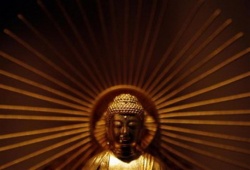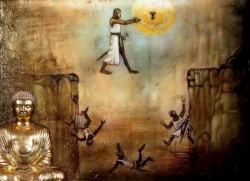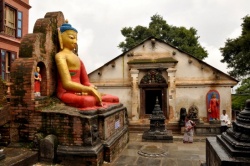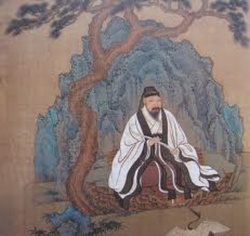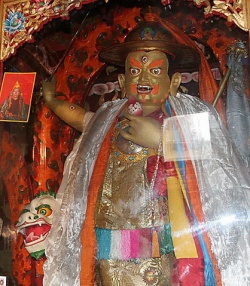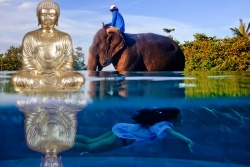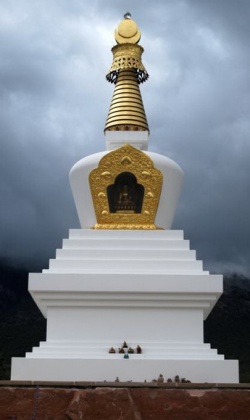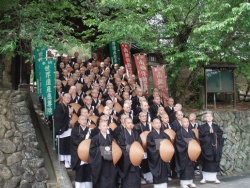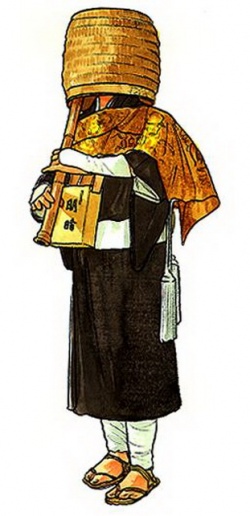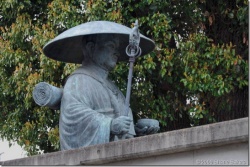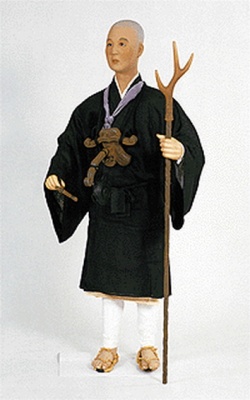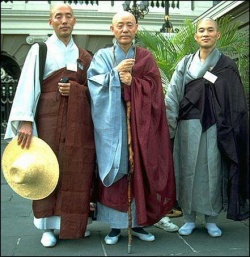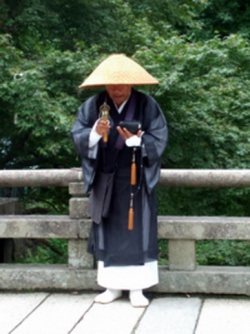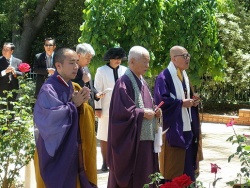Buddha-nature
Buddha-nature, Buddha-dhatu or Buddha Principle (Skt: Buddha-dhātu, Tathāgatagarbha; Jap: Bussho), is taught differently in various Mahayana Buddhism traditions.
Broadly speaking Buddha-nature is concerned with ascertaining what allows Sentient beings to become Buddhas.
The term, Buddha nature, is a translation of the Sanskrit coinage, 'Buddha-dhātu', which seems first to have appeared in the Mahayana Mahaparinirvana Sutra,, where it refers to 'a sacred nature that is the basis for beings' becoming Buddhas.'
Buddha-nature (Fo-xing) or the potential for becoming a Buddha is possessed equally by all sentient beings.
The difference between a Buddha and an ordinary living being is that a Buddha has realized his or her Buddha-nature, while an ordinary being has not. It is often called the essence of Buddhahood or enlightened essence.
Also called dharmakaya, original nature, original face, Tathagatagarbha.
See; “three turnings of the wheel of dharma.”
Buddha Nature - (Sugatagarbha / bde gshegs snying po) *It is not an "entity" but ultimate nature of mind, free from veils of ignorance.
Every sentient being has the potential to actualize this buddha nature by revealing perfect knowingness through pristine cognition of this nature of mind. This is in a way the "primordial goodness" of sentient beings.
The innate all-pervasive primordial purity. MR
Sugata garbha, the essence of the sugatas; the potential for enlightenment or enlightened nature that is inherently present in each sentient being.
For a detailed discussions, see Thrangu Rinpoche's 'Buddha Nature,' Rangjung Yeshe Publications. RY
Etymology
Add etymology of Sanskrit and/or Tibetan terms here...
Relevance
- The buddha nature principle is most directly linked with Buddha Shakyamuni's third turning of the wheel of Dharma,
where he addressed this topic at length in such sutras as Tathagatagarbha Sutra, the Mahayana Mahaparinirvana Sutra, and the Lankavatara Sutra, amongst others.
Despite their roots in the Sutra tradition of the Mahayana, these teachings are also closely linked with the view and practice of the various Vajrayana traditions, such as Mahamudra and Dzogchen. CJD
Related Terms
Etymology
Buddha-nature (Classical Chinese: 佛性, modern pinyin fó xìng) literally corresponds to the Sanskrit Buddha-dhātu - "Buddha Element", "Buddha-Principle", but seems to have been used most frequently to translate the Sanskrit "Tathāgatagarbha".
The Sanskrit term "Tathāgatagarbha" may be parsed into Tathāgata ("the one thus gone", referring to the Buddha) and garbha ("root/embryo").
The latter has the meanings: "embryo", "essence"; whilst the former may be parsed into "tathā" ("(s)he who has there" and "āgata" (semantic field: "come", "arrived") and/or "gata" ("gone").
For the various equivalents of the Sanskrit term "Tathāgatagarbha" in other languages (Chinese, Japanese, Vietnamese), see Glossary of Buddhism, "Tathagatagarbha"
Development of the concept of Buddha-nature
The idea of Buddha-nature originated in India, and was further developed in China, due to the different culture Buddhism had to adapt to.
It was the result of an interplay between various strands of Buddhist thought, on the nature of human consciousness and the means of awakening.
Early Indian Buddhism
Nikayas - Luminous mind
The idea of the Tathagatagarbha is grounded on sayings by the Buddha that there is an innately pure Luminous mind (prabhasvara Citta), "which is only adventitiously covered over by defilements (agantukaklesa)" This Luminous mind is being mentioned in the Anguttara Nikaya::
The Mahāsāṃghika coupled this idea of the Luminous mind with the idea of the mulavijnana, the substratum consciousness that serves as the basis consciousness.
Abhidhamma - The seed of awakening
The Buddha-nature doctrine may be traced back, in part, to the abhidharmic debates over metaphysics.
Those arose among the Nikāya schools as they attempted to reconcile various perceived problems.
One problem is how to integrate the doctrine of anatta with the idea of Karma and Rebirth.
The anatta-doctrine stipulates that there is no underlying self, while the idea of Karma and Rebirth seems to implicate an underlying essence that's being reborn.
A solution to this problem was the proposition of the existence of karmic seeds.
The karmic effects of the human deeds lay dormant, as seeds, until they germinate in this or a next life.
Not an individual self, but these karmic seeds are the base for the generation of a following life.
This concept of "seeds" was espoused by the Sautrāntika in debate with the Sarvāstivādins over the metaphysical status of phenomena (dharmas).
It is a precursor to the ālaya-Vijñāna, the store-consciousness of the Yogācāra school which contains all these seeds.
Originally ālaya-Vijñāna simply meant {defiled consciousness: defiled by the workings of the five senses and the mind.
It was also seen as the mūla-Vijñāna, the base-consciousness or "stream of consciousness" from which awareness and perception spring.
According to Yogacara, awakening is the result of a seed that comes from outside the human psyche, namely by hearing the teaching.
Indian Mahayana
Avatamsaka Sutra
The Avatamsaka Sutra (1st-3rd century CE) was the next step in the development of the Buddha-nature thought,
- [W]here it is taught that the Buddha's divine knowledge pervades Sentient beings, and that its representation in an individual being is the substratum consciousness.
The Avatamsaka Sutra does not contain a "singular discussion of the concept", but the idea of "a universal penetration of Sentient beings by the Wisdom of the Buddha (buddhajnana)" was complementary to the concept of the Buddha-womb.
The basic idea of the Avatamsaka Sutra is the unity of the absolute and the relative:
- All in One, One in All. The All melts into a single whole.
There are no divisions in the totality of reality [...] [I]t views the cosmos as holy, as "one bright pearl," the universal reality of the Buddha.
The universal Buddhahood of all reality is the religious message of the Avatamsaka-Sutra.
Each part of the world reflects the totality of the cosmos:
In each dust-mote of these worlds
Are countless worlds and Buddhas...
From the tip of each hair of Buddha's body
Are revealed the indescribable Pure Land's...
The indescribable infinite Lands
All ensemble in a hair's tip [of Buddha.
All levels of reality are related and interpenetrated.
This is depicted in the image of Indra's net. This "unity in totality allows every individual entity of the phenomenal world its uniqueness without attributing an inherent nature to anything".
Tathāgatagarbha Sutras
- See also: Tathāgatagarbha Sutras
From the idea of the Luminous mind emerged the idea that the awakened mind is the pure, undefiled mind.
In the Tathagatagarbh-sutras it is this pure consciousness that is regarded to be the seed from which Buddhahood grows:
- When this intrinsically pure consciousness came to be regarded as an element capable of growing into Buddhahood, there was the "embryo (garbha) of the Tathagata (=Buddha)" doctrine, whether or not this term is employed.
Gregory comments on this origin of the Tathagatagarba-doctrine:
- The implication of this doctrine [...] is that Enlightenment is the natural and true state of the mind.
The early Buddha-nature concept as expressed in the seminal 'Tathagatagarbha Sutra' named the Nirvana Sutra is, according to Kevin Trainor, as follows:
'Sentient beings are said to possess a sacred nature that is the basis for them becoming Buddhas ... this buddha-nature is in fact our true nature ... universal and completely unsullied by whatever psychological and karmic state an individual may be in.'
The Tathagatagarbha-sutras originated in India, but their ideas were more influential in the development of East Asian Buddhism.
The earliest Tathagata-garbha Sutra is the Tathāgatagarbha Sūtra.
The most important of those sutras is The Lion's Roar of Queen Srimala.
Another influential Sutra, especially in Chinese thought, is the Mahāparinirvāṇa Sūtra.
The Uttaratantra gives a synthesis of Tathagatagarbha-thought, and gives an overview of authoritative Tathagatagarbha sutras.
Tathāgatagarbha Sūtra
The Tathāgatagarbha Sūtra (200-250 CE) is considered...
- ... the earliest expression of this [the tathāgatagarbha doctrine) and the term tathāgatagarbha itself seems to have been coined in this very sutra."
It states that one is already or primordially awakened.
Śrīmālādevī Sūtra
The Śrīmālādevī Siṃhanāda Sūtra (2rd century CE), also named The Lion's Roar of Queen Srimala, centers on the teaching of the Tathagatagarbha as "ultimate soteriological principle".
Regarding the Tathagata-garbha it states:
- Lord, the Tathagatagarbha is neither self nor sentient being, nor soul, nor personality.
The Tathagatagarbha is not the domain of beings who fall into the belief in a real personality, who adhere to wayward views, whose thoughts are distracted by voidness.
Lord, this Tathagatagarbha is the embryo of the Illustrious Dharmadhatu, the embryo of the Dharmakaya, the embryo of the supramundane Dharma, the embryo of the intrinsically pure Dharma.
In the Śrīmālādevī Sūtra, there are two possible states fot the Tathagatagarbha:
- Either covered by defilement's, when it is called only "embryo of the Tathagata"; or free from defilement's, when the "embryo of the Tathagata" is no more the "embryo" (potentiality) but the Tathagata (=the Dharmakaya)(actuality).
The Sutra itself states it this way:
- This Dharmakaya of the Tathagata when not free from the store of defilement is referred to as the Tathagatagarbha.
Mahayana Mahaparinirvana Sutra=
The Mahayana Mahaparinirvana Sutra (written 2nd century CE) was very influential in the Chinese reception of the Buddhist teachings.
This Sutra was understood to postulate an underlying essence, 'the true Self', as it sometimes terms the Buddha-nature of all beings, though this Sutra is ambivalent.
The Mahāyāna Mahāparinirvāṇa Sūtra states that Buddha-nature is everlasting, pure and blissful, and is 'the Self of living beings'.
The self of which the Buddha speaks is said by him to be the "essential intrinsic being" (Svabhava) or even "life-essence" (jīvaka) of each person,
and this essential being is none other than the Buddha himself - "radiantly luminous" and "as indestructible as a diamond".
The Buddha-nature is taught to be an ultimate, conceptually inconceivable, immortal reality.
But the Mahaparinirvana-Sutra also contrasts its doctrine of the True Self with that of the Astikas.
The Astikas were the orthodox teachings of India, embracing the idea of Atman.
The Sutra rejects the idea of the self as an indwelling miniature man, a homunculus:
- Mundane philosophers mistakenly imagine it to be a person (puruṣa) the size of a thumb, the size of a pea or a grain of rice that dwells shining in the heart.
This, the Buddha says, is a misconception of the nature of self, for:
- That opinion of theirs is a mistaken opinion, one that is transmitted onwards from person to person, but it is neither beneficial nor conducive to happiness....
Worldly beings do not comprehend the reality of the Self (ātma-tattva); they fall under the sway of unwholesome friends, and do not understand the Tathāgata’s utterances with implicit meaning, they meditatively cultivate the notion that they lack the Self, even though there is the Self.
Ratnagotravibhāga Uttaratantra)
The Uttaratantra (5th century CE) is a sastra in which
- The various insights and developments of the above texts (all of which served as its sources) were to be comprehensively synthesised into the most authoritatively complete analysis of the Tathagatagarbha theory.
It gives an overview of authoritative Tathagatagarbha sutras, mentioning the Tathāgatagarbha Sūtra, the Śrīmālādevī Sūtra, Mahāparinirvāṇa Sūtra, the Angulimaliya Sutra, the Anunatva-Apurnatva-Nirdesa and the Mahābherīharaka-Sūtra.
According to the Ratnagotravibhāga,
- Thusness tathata defiled is the Tathagatagarbha, and Thusness undefiled is Enlightenment.
The Ratnagotravibhāga equates Enlightenment with the Nirvana-realm and the Dharmakaya.
Lotus Sutra
The Lotus Sutra (written between 100 BCE and 200 CE) further developed and popularized the doctrine of the Buddha-nature. It influenced subsequent later sutras.
The tenth chapter emphasizes, in accordance with the Bodhisattva-ideal of the Mahayana-teachings, that everyone can be liberated.
All living beings can become a buddha,
not only monks and nuns, but also laypeople, shravakas, bodhisattvas, non-human creatures, dragon kings and centaurs.
It also details that all living beings can be a 'teacher of the Dharma'.
The twelfth chapter of the Lotus Sutra details that Buddha nature is universal among all people. Even the historical Devadatta has the potential to become a buddha.
The story of Devadatta is followed by another story about a dragon princess who is both a Nāga and a female, whom the Bodhisattva Mañjuśrī proclaims will reach Enlightenment immediately, in her present form.
Trikaya
Mahayana Buddhism developed new ideas on the appearance of the Buddha.
These ideas first appeared in the Lotus Sutra, which distinguishes between the heavenly Buddha and earthly Buddhas.
Around 300 CE, the Yogacara school systematized the prevalent ideas on the nature of the Buddha in the Trikaya or three-body doctrine.
According to this doctrine, Buddhahood three aspects
- The Nirmana-kaya, or Transformation-body,
- The Sambhogakāya, or Enjoyment-body,
- The Dharmakāya, or Dharma-body.
The Transformation-body is the earthly manifestation of the Buddha.
The Enjoyment-body is a subtle body, by which the Buddha appears to bodhisattvas to teach them.
the Dharma-body refers to both the ]]ultimate nature of the Buddha)], and to the ultimate nature of reality:
- The first is the 'Knowledge-body' (Jnana-kaya), the inner nature shared by all Buddhas, their Buddha-ness (buddhata)
- [...] The second aspect of the Dharma-body is the 'Self-existent-body' (Svabhavika-kaya).
This is the ultimate nature of reality, thusness, emptiness: the non-nature which is the very nature of dharmas, their Dharma-ness (Dharmata).
It is the Tathagata-garbha and Bodhi-Citta hidden within beings, and the transformed 'storehouse-consciousness'.
Tathagatagarbha and Alayavijnana
The Lankavatara Sutra "assimilates Tathagata-garbha thought to the Yogacara-viewpoint, and this assimilation is further developed in [...] The Treatise on the Awakening of Faith in the Mahayana".
Lankavatara-Sutra
The Lankavatara Sutra (compiled 350-400 CE) synthesized the tathagatagarba-doctrine and the alija-Vijnana doctrine.
The alija-Vijnana is supposed to contain the pure seed, or Tathagatagarbha, from which awakening arises.
The Lankavatara-Sutra contains Tathagata-garba thought, but also warns against reification of the idea of Buddha-nature, and presents it as an aid to attaining awakening:
- Is not this Tathagata-garbha taught by the Blessed One the same as the ego-substance taught by the philosophers? The ego as taught by the philosophers is an eternal creator, unqualified, omnipresent, and imperishable.
- The Blessed One replied: [...] it is emptiness, reality-limit, Nirvana, being unborn, unqualified, and devoid of will-effort; the reason why the Tathagatas [...] teach the doctrine pointing to the Tathagata-garba is to make the ignorant cast aside their fear when they listen to the teaching of ego-lessness and to have them realise the state of non-discrimination and imagelessness
According to Wayman & Wayman, the equation of Tathagatagarbha and alijavijnana in the Lankavatara fails:
- It is plain that when the Lankavatara-Sutra identifies the two terms, this scripture necessarily diverges in the meaning of one or both of the terms from the usage of the term Tathagatagarbha in the earlier Sri-Mala or of the term Alayavijnana in the subsequent Yogacara school.
The Awakening of Faith
The Awakening of Faith (translated into Chinese 6th century CE) was very influential in the development of Chinese Buddhism. It tried to harmonize the ideas of the Tathāgatagarbha and ālayavijñāna:
- In the words of the Awakening of Faith — which summarizes the essentials of Mahayana — self and world, mind and suchness, are integrally one.
Everything is a carrier of that a priori Enlightenment; all incipient Enlightenment is predicated on it.
The mystery of existence is, then, not, “How may we overcome alienation?” The challenge is, rather, “Why do we think we are lost in the first place?”
Tantra
Mahāvairocana Sūtra
The Mahāvairocana Sūtra (7th century) mentions the self in a very affirmative manner:
- Those who have been initiated into the Mahayana Mandala Arising from Great Compassion, who are honest and pliant, and who always have great compassion [...] They know their hearts to be the Great Self.
Chinese Mahayana
When Buddhism was introduced to China, in the first century CE, Buddhism was understood through comparisons of its teachings to Chinese terms and ways of thinking.
Immortality and emptiness, central notions in Taoïsm, gave a frame of reference for the understanding of reincarnation and Sunyata.
In the Chinese thinking of that time reincarnation was only possible if there was a soul or essence to reincarnate. Early Chinese Buddhism therefore assumed that this was also the teaching of the Buddha.
In the 6th century CE it dawned that anatman and Sunyata are central Buddhist teachings, which make the postulation of an eternal self problematic.Template:Lai
Another point of confusion was the Two truths doctrine of Madhyamaka, the relative truth and the absolute truth.
Chinese thinking took this to refer to two ontological truths: reality exists of two levels, a relative level and an absolute level.
But in Madhyamaka these are two epistemological truths: two different ways to look at reality.
Based on their understanding of the Mahayana Mahaparinirvana Sutra the Chinese supposed that the teaching of the Buddha-nature was, as stated by that Sutra, the final Buddhist teaching, and that there is an essential truth above Sunyata and the two truths.
Halfway through the 6th century CE the Awakening of Faith in the Mahayana took shape, in which a synthesis was offered of Chinese buddhist thinking.
In the Awakening of Faith the 'one mind' has two aspects, namely Tathata, suchness, the things as they are, and Samsara, the cycle of birth and death.
This Sutra was in line with an essay by emperor Wu of the Liang Dynasty (reign 502-549 CE), in which he postulated a pure essence, the enlightened mind, trapped in darkness, which is ignorance. By this ignorance the pure mind is trapped in Samsara.
This resembles the Tathagata-garba and the idea of the defilement of the Luminous mind.
In a commentary on this essay Shen Yue stated that insight into this true essence is awakened by stopping the thoughts - a point of view which is also being found in the Platform Sutra of Hui-neng.
The joining together of these different ideas supported the notion of the Lotus ekayana, the one vehicle: absolute oneness, all-pervading Buddha-Wisdom and original Enlightenment as a holistic whole.
This synthesis was a reflection of the unity which was attained in China with the united Song Dynasty.
Interpretation within Buddhist traditions
Indian Mahayana Buddhism
Prajna-paramita sutras
The Prajna-paramita sutras, which emerged from the first century BCE on, reject the idea of an eternal self or underlying essence. They emphasize the notion of emptiness.
According to Kalupahana they are an early reaction to the "emergence of absolutist tendencies".
The Sutra of Perfect Wisdom, also called The Questions of Suvikrantavikramin, states it's view on the self in this way:
- [O]ne who wisely knows himself (atmanam) as nondual, he wisely knows both Buddha and Dharma. And why? He develops a personality which consists of all dharmas [...]
His nondual comprehension comprehends all dharmas, for all dharmas are fixed on the Self in their own-being.
One who wisely knows the nondual Dharma wisely knows also the Buddhadharmas.
From the comprehension of the nondual Dharma follows the comprehension of the Buddhadharmas and from the comprehension of the Self the comprehension of everything that belongs to the triple world.
"The comprehension of Self", that is the beyond of all dharmas.
Madhyamaka
It is possible to do a Madhyamaka interpretation of Tathāgatagarbha literature.
According to Kalupahana, the Madhyamaka of Nagarjuna, but also the Yogacara of Vasubandhu are a later reaction to the "emergence of absolutist tendencies".
Nagarjuna's work is founded on the prajnaparamita-sutras, which reach back to the anatman doctrine.
Yogacara
Vasubandhu gives an analysis of the workings of the human mind and consciousness, based on the analysis of the working of the Five Skandhas.
Vasubandhu's original analysis leaves ample room for the proposition of a transcendent essence, but was interpreted in an idealist way by later followers.
Tibetan Buddhism
According to the Nyingma and Sakya schools, Tathāgatagarbha is the inseparability of the clarity and emptiness of one's mind. According to the Gelug school, it is the potential for Sentient beings to awaken since they are empty (i.e.
According to the Jonang school, it refers to the innate qualities of the mind which expresses itself in terms of omniscience etc. when adventitious obscurations are removed.
Nyingma
Speaking for the Tibetan Nyingma tradition, Tulku Urgyen Rinpoche sees an identity between the Buddha-nature, Dharmadhātu (essence of all phenomena and the noumenon) and the Three Vajras, saying:
- Dharmadhatu is adorned with Dharmakaya, which is endowed with dharmadhatu Wisdom.
This is a brief but very profound statement, because "dharmadhatu" also refers to sugata-garbha or buddha nature. Buddha nature is all-encompassing ...
This buddha nature is present just as the shining sun is present in the sky.
It is indivisible from the Three Vajras [i.e. the Buddha's Body, Speech and Mind of the awakened state, which do not perish or change.
The Nyingma meditation masters, Khenchen Palden Sherab and Khenpo Tsewang Dongyal, emphasise that the essential nature of the mind (the Buddha-nature) is not a blankness, but is characterised by wonderful qualities and a perfection that is already present and complete:
- The nature of the mind is not hollow or blank; it is profound and blissful and full of wonderful qualities... meditation practice reveals our true nature as being totally perfect and complete.
They add:
- The true nature of mind is beyond conception, yet it is present in every object.
The true nature is always there, but due to our temporary obscurations we do not recognize it ...
The primordial nature is beyond conceptions; it cannot be explained ... cannot be encompassed by words.
Although you can say it is clarity and vastness, you cannot see it or touch it; it is beyond expression.
Kagyu
In the Tibetan Kagyu tradition, Thrangu Rinpoche sees the Buddha nature as the indivisible oneness of Wisdom and emptiness:
- The union of Wisdom and emptiness is the essence of Buddha-hood or what is called Buddha-nature (Skt. Tathagata-garbha) because it contains the very seed, the potential of Buddhahood.
It resides in each and every being and because of this essential nature, this heart nature, there is the possibility of reaching Buddhahood.
Gelukpa
The 14th Dalai Lama, representing the Gelukpa School of Tibetan Buddhism, and speaking from the Madhyamaka philosophical position, sees the Buddha-nature as the "original clear light of mind",
but points out that it ultimately does not exist independently, because, like all other phenomena, it is of the nature of emptiness:
- Once one pronounces the words "emptiness" and "absolute", one has the impression of speaking of the same thing, in fact of the absolute.
If emptiness must be explained through the use of just one of these two terms, there will be confusion. I must say this; otherwise you might think that the innate original clear light as absolute truth really exists.
Jonangpa
The Jonangpa School of Tibetan Buddhism, whose foremost historical figure was the Tibetan scholar-Monk Dolpopa, sees the Buddha-nature as the very ground of the Buddha himself, as the "permanent indwelling of the Buddha in the basal state".
Dolpopa comments that certain key Tathāgatagarbha sutras indicate this truth.
Moreover, the Buddhist tantric scripture entitled Chanting the Names of Mañjuśrī (Mañjuśrī-nāma-saṅgīti), repeatedly exalts, as portrayed by Dolpopa,
not the non-Self but the Self, and applies the following terms to this ultimate reality : 'The Buddha-Self, the beginningless Self, the solid Self, the diamond Self'.
These terms are applied in a manner which reflects the cataphatic approach to Buddhism, typical of much of Dolpopa's writings.
Dolpopa further expressed the viewpoint that the Buddha-nature transcends the chain of Dependent origination.
It is not empty of its own ultimately real essence, but only of extraneous, transitory and relative phenomena.
Dr. Cyrus Stearns writes on Dolpopa's attitude to the 'third turning of the wheel' doctrines (i.e. the Buddha-nature teachings):
- The Third Turning of the Dharma Wheel presented the teachings on the Buddha nature, which are the final definitive statements on the nature of ultimate reality, the primordial ground or substratum beyond the chain of Dependent origination, and which is only empty of other, relative phenomena.'
In the Gandavyuha Sutra (as quoted by Longchenpa) this Buddha essence is said to be the ground of all things:
- ... the ultimate universal ground also has always been with the Buddha-Essence (Tathagatagarbha), and this essence in terms of the universal ground has been taught by the Tathagata.
The fools who do not know it, because of their habits, see even the universal ground as (having) various happiness and Suffering and actions and emotional defilements.
Its nature is pure and immaculate, its qualities are as wishing-jewels; there are neither changes nor cessations. Whoever realizes it attains Liberation ...
Dzogchen
Germano relates Dzogchen, via Buddha-nature to Madhyamaka, Yogachara and Abhinavagupta:
- ...the Great Perfection represents the most sophisticated interpretation of the so-called "Buddha nature" tradition within the context of Indo-Tibetan thought,
and as such, is of extreme importance for research into classical esoteric philosophic systems such as Madhyamaka and
Yogacara, while also providing fertile grounds for future explorations of the interconnections between Indo-Tibetan and East Asian forms of Buddhism,
as well as between Indo-Tibetan Buddhism and contemporary Indian developments such as the tenth century non-dual Shaivism of Abhinavagupta.
The 19th/20th-century Tibetan Buddhist scholar, Shechen Gyaltsap Gyurme Pema Namgyal, sees the Buddha nature as ultimate truth, Nirvana, which is constituted of profundity, primordia peace and radiance:
- Buddha-nature is immaculate.
It is profound, serene, unfabricated suchness, an uncompounded expanse of luminosity; nonarising, unceasing, primordial peace, spontaneously present Nirvana.
The Rimé movement
Ringu Tulku says,
- There has been a great deal of heated debate in Tibet between the exponents of Rangtong, (Wylie: Rang-stong) and Shentong, (Wylie: gZhan-stong) philosophies. The historic facts of these two philosophies are well known to the Tibetologists.
Jamgon Kongtrul says about the two systems:
- Madhyamika philosophies have no differences in realising as 'Shunyata', all phenomena that we experience on a relative level.
They have no differences also, in reaching the meditative state where all extremes (ideas) completely dissolve.
Their difference lies in the words they use to describe the Dharmata.
Shentong describes the Dharmata, the mind of Buddha, as 'ultimately real';
while Rangtong philosophers fear that if it is described that way, people might understand it as the concept of 'soul' or 'Atma'.
The Shentong philosopher believes that there is a more serious possibility of misunderstanding in describing the Enlightened State as 'unreal' and 'void'.
Kongtrul finds the Rangtong way of presentation the best to dissolve concepts and the Shentong way the best to describe the experience.
In 2006, Khentrul Rinpoche Jamphal Lodro founded "The Tibetan Buddhist Rimé Institute" in Melbourne, Australia.
It aims to propagate the Rimé view of harmony within all Buddhist traditions and to introduce the rare Jonang Kalachakra Tantra lineage teachings in the western world.
Chinese Buddhism
Tiantai
Based on the metaphors of the Lotus Sutra, Tiantai developed the teaching of revealing the Buddha nature in one's current form.
Chán
In Chinese Ch’an Buddhism the Buddha-nature tends to be seen as the essential nature of all beings. But the Zen tradition also emphasizes that Buddha-nature is Sunyata, the absence of an independent and substantial "self"..
Lankavatara Sutra
The understanding of the Tathāgatagarbha in Zen is connected to the Laṅkāvatāra Sūtra.
The Laṅkāvatāra Sūtra presents the Chan/Zen Buddhist view of the Tathāgatagarbha:
- [The Buddha said,] Now, Mahāmati, what is perfect knowledge?
It is realised when one casts aside the discriminating notions of form, name, reality, and character; it is the inner realisation by noble Wisdom.
This perfect knowledge, Mahāmati, is the essence of the Tathāgata-garbha.
Alayavijñāna
lso as described in the Laṅkāvatāra Sūtra, in Chan/Zen the Tathāgatagarbha is identical to the ālayavijñāna, known prior to awakening as the storehouse-consciousness or 8th consciousness.
Chan/Zen masters from Huineng in 7th century China to Hakuin in 18th century Japan to Hsu Yun in 20th century China, have all taught that the process of awakening begins with the light of the mind turning around within the 8th consciousness,
so that the ālayavijñāna, also known as the Tathāgatagarbha, is transformed into the "bright mirror Wisdom".
When this active transformation is complete the other seven consciousnesses are also transformed.
The 7th consciousness of delusive discrimination becomes transformed into the "equality Wisdom".
The 6th consciousness of thinking sense becomes transformed into the "profound observing Wisdom", and the 1st to 5th consciousnesses of the five sensory senses become transformed into the "all-performing Wisdom".
Vajrasamadhi-Sutra (685 CE)
In the Korean Vajrasamādhi Sūtra Tathāgatagarbha is presented as being possessed of two elements, one essential, immutable, changeless and still, the other active and salvational:
- This 'Dharma of the one mind', which is the 'original Tathagatagarbha', is said to be 'calm and motionless' ...
The Vajrasamadhi's analysis of Tathagatagarbha also recalls a distinction the Awakening of Faith makes between the calm, unchanging essence of the mind and its active, adaptable function [...]
The Tathagatagarbha is equated with the 'original edge of reality' (bhutakoti) that is beyond all distinctions - the equivalent of original Enlightenment, or the essence.
But Tathagatagarbha is also the active functioning of that original Enlightenment - 'the inspirational Power of that fundamental faculty' ....
The Tathagatagarbha is thus both the 'original edge of reality' that is beyond cultivation (= essence) as well as the specific types of Wisdom and mystical talents that are the byproducts of Enlightenment (= function).
Contemporary Chán/Zen-understanding
According to Heng-Ching Shih, the teaching of the universal Buddha-nature does not intend to assert the existence of substantial, entity-like self endowed with excellent features of a Buddha.
Rather, Buddha-nature simply represents the potentiality to be realized in the future.
Master Hsing Yun, forty-eighth patriarch of the Linji School of Ch’an Buddhism, equates the Buddha-nature with the Dharmakāya in line with pronouncements in key Tathāgatagarbha sutras.
He defines these two as:
- the inherent nature that exists in all beings. In Mahāyāna Buddhism, Enlightenment is a process of uncovering this inherent nature … The Buddha nature [is] identical with transcendental reality.
The unity of the Buddha with everything that exists.
Japanese Buddhism
Nichiren Buddhism
Nichiren (1222–1282) was a Buddhist monk who taught devotion to the Lotus Sutra as the exclusive means to attain Enlightenment, and the chanting of Nam-Myōhō-Renge-Kyō as the essential practice of the teaching.
Nichiren Buddhism includes various schools with diverging interpretations of Nichiren's teachings.
Nichiren Buddhism views the Buddha nature as "The inner potential for attaining Buddhahood", common to all people.
Based on the Lotus Sutra, Nichiren maintained that "all living being possess the Buddha nature", being the inherent potential to attain Buddhahood :
- The Buddha nature refers to the potential for attaining Buddhahood, a state of awakening filled with compassion and Wisdom.
The emphasis in Nichiren Buddhism is on "revealing the Buddha nature" - or attaining Buddhahood – in this life time through chanting the name of the Dharma of the Lotus Surra:
- Tthe Buddha nature within us is summoned forth and manifested by our chanting of Nam-myoho-renge-kyo.
The potential for Buddhahood exists in the whole spectrum of the Ten Worlds of life, and this means that all people,
including evil doers, have Buddha nature, which remains as a dormant possibility or a theoretical potential in the field of emptiness or non-substantiality until it is materialized in reality through Buddhist practice.
In his letter "Opening the Eyes of Wooden and painted Images" Nichiren explains that insentient matter (such as trees, mandalas, images, statues) also possess the Buddha nature, because they serve as objects of worship.
This view regards the Buddha nature as the original nature of all manifestations of life – sentient and insentient – through their interconnectedness:
- This concept of the Enlightenment of plants in turn derives from the doctrine of three thousand realms in a single moment of life, which teaches that all life—insentient and sentient—possesses the Buddha nature.
Modern scholarship
Modern scholarship points to the various possible interpretations of Buddha Nature as either an essential self, as Sunyata, or as the inherent possibility of awakening.
Essential self
Shenpen Hookham, Oxford Buddhist scholar and Tibetan Lama of the Shentong tradition writes of the Buddha-nature or "true self" as something real and permanent, and already present within the being as uncompounded Enlightenment.
She calls it "the Buddha within", and comments:
- In scriptural terms, there can be no real objection to referring to Buddha, Buddhajnana Buddha Awareness/ Buddha Knowledge, Nirvana and so forth as the True Self, unless the concept of Buddha and so forth being propounded can be shown to be impermanent, Suffering, compounded, or imperfect in some way ... in Shentong terms,
the non-self is about what is not the case, and the Self of the Third Dharmachakra [i.e. the Buddha-nature doctrine is about what truly IS.
Buddhist scholar and chronicler, Merv Fowler, writes that the Buddha-nature really is present as an essence within each being. Fowler comments:
- The teaching that Buddha-nature is the hidden essence within all Sentient beings is the main message of the Tathagatagarbha literature, the earliest of which is the Tathagatagarbha Sutra.
This short Sutra says that all living beings are in essence identical to the Buddha regardless of their defilements or their continuing transmigration from life to life...
As in the earlier traditions, there is present the idea that Enlightenment, or Nirvana, is not something which has to be achieved, it is something which is already there... In a way, it means that everyone is really a Buddha now.
Sunyata
According to Heng-Ching Shih, the Tathāgatagarbha/Buddha nature does not represent a substantial self (ātman).
Rather, it is a positive language expression of emptiness (śūnyatā), which emphasizes the potentiality to realize Buddhahood through Buddhist practices.
The intention of the teaching of Tathāgatagarbha/Buddha nature is soteriological rather than theoretical.
Paul Williams puts forward the Madhyamaka interpretation of the Buddha-nature as emptiness in the following terms:
- … if one is a Madhyamika then that which enables Sentient beings to become Buddhas must be the very factor that enables the minds of Sentient beings to change into the minds of Buddhas.
That which enables things to change is their simple absence of inherent existence, their emptiness.
Thus the Tathagatagarbha becomes emptiness itself, but specifically emptiness when applied to the mental continuum.
Critical Buddhism
According to Matsumoto Shiro and Hakamaya Noriaki, essentialist conceptions of Buddha-nature are at odds with the fundamental Buddhist doctrine of Dependent origination.
Sallie B King objects their view. She sees the Buddha-nature as a metaphor for the potential in all beings to attain Buddhahood, rather than as an ontological reality.
This view of the Buddha-nature as non-Buddhist is termed Critical Buddhism.
Paul Williams has criticized this view, saying that Critical Buddhism is too narrow in its definition of what constitutes Buddhism. According to Williams,
- We should abandon any simplistic identification of Buddhism with a straightforward not-Self definition".
Multiple meanings
Sutton agrees with this critique on the narrowness of interpretation.
In discussing the inadequacy of modern scholarship on Buddha-nature, Sutton states,
- One is impressed by the fact that these authors, as a rule, tend to opt for a single meaning disregarding all other possible meanings which are embraced in turn by other texts".
He goes on to point out that the term Tathāgatagarbha has up to six possible connotations. Of these, he says the three most important are:
- an underlying ontological reality or essential nature (Tathāgata-tathatā-'vyatireka) which is functionally equivalent to a self (ātman) in an Upanishadic sense,
- the Dharma-kāya which penetrates all beings (sarva-sattveṣu Dharma-kāya-parispharaṇa), which is functionally equivalent to brahman in an Upanishadic sense
- the womb or matrix of Buddhahood existing in all beings (Tathāgata-gotra-saṃBhava), which provides beings with the possibility of awakening.
Of these three, Sutton claims that only the third connotation has any soteriological significance, while the other two posit Buddha-nature as an ontological reality and essential nature behind all phenomena.
Even in the earliest strata of Buddhist literature that has survived to the present, the Buddha is portrayed in a variety of ways.
Some passages depict him as a man who skilfully answers questions that have been put to him, either by answering the questions or by showing why the question as asked cannot be answered.
The passages were clearly designed to portray the Buddha as a paragon of wisdom, whose careful and analytic thinking could be used as a model for those seeking to arrive at correct understanding.
The Buddha is also portrayed as a model of virtue, a man who has mastered the art of living in the world without bringing harm to other living beings and whose concern for the welfare of all living things around him is unsurpassed.
Interspersed with these passages that focus on the Buddha as a remarkable man, there are other passages that portray the Buddha as a superhuman miracle worker whose mastery of yogic technique has given him the power to travel hundreds of kilometres in the blink of an eye,
transport himself and his followers through the air,
know the precise thoughts of other people, see into the past and future, heal serious wounds merely by looking at them, and soothe wild and dangerous animals by merely speaking gently to them.
Some texts show him inviting his followers to question everything he says and to accept nothing on his authority; in other passages,
he is portrayed as a man to whom even the wisest and most knowledgeable gods come so that the profound mysteries of the universe can be explained to them in clear words.
Given the diversity of things said about the Buddha in the texts that Buddhists regarded as authoritative, it is no wonder that among the points about which there was considerable controversy was the nature of the Buddha himself.
Discussions about the nature of the Buddha were as important to some Buddhist philosophers as discussions about the nature of God were to the theologians of theistic traditions (see Buddha).
The earliest extant record of controversies concerning the nature of the Buddha is a work known as Kathāvatthu (Points of Controversy), supposed to have been written around 246 bc by an elder monk known as Tissa Moggalīputta.
This treatise mentions over two hundred topics over which there was controversy among Buddhists, of which several pertain to the nature of the Buddha.
According to this text, some Buddhists held to the view that the Buddha pervades all regions of space at all times and has the power to suspend all the laws of nature at will;
others argued that the Buddha exists only where his human body is located and that he is bound by all the natural laws by which other living beings are bound.
Those who accepted the Buddha as a ubiquitous and eternal entity tended to claim that the human Buddha was merely a manifestation in human form that appeared for the sake of guiding human beings.
This apparition, they claimed, had no real need for food and shelter or other material requirements of life, but it accepted such gifts from devotees so that they might learn the benefits of generosity.
Moreover, this apparition was said to be wholly lacking any of the unpleasant physical or mental traits of a human being and never had any thoughts that were not directed at teaching people how to cultivate virtue and attain nirvāṇa.
Other Buddhists rejected this view of the Buddha altogether and argued that he was a mortal just like all other mortals,
except that among the limited range of topics about which he had knowledge was the important matter of how to achieve lasting peace and happiness.
This issue was controverted for over a millennium in India, with Dharmakīrti and some of his followers taking up the view of the Buddha as an ordinary mortal,
while some members of the Yogācāra movement took up the position that the Buddha was more of a cosmic principle;
the eleventh-century Buddhist Ratnakīrti eventually argued that all particular acts of individual awareness are merely parts of a single, universal consciousness,
which he identified as the mind of the Buddha (see Buddhism, Yogācāra school of).
The position taken by Ratnakīrti may be the logical conclusion of an idea first mentioned in the Kathāvatthu, namely, that one becomes an Awakened One (buddha) by acquiring a quality known as awakening (bodhi).
Tissa Moggalīputta himself rejected this idea, arguing that if awakening were something that one could attain, it would also be something that one could lose, in which case a buddha could cease to be a buddha; his view, therefore, was that awakening is not a positive trait but merely the absence of delusions.
Dissenting from this view, other Buddhists (and especially members of the Yogācāra school) argued that buddhas become buddhas as a result of realizing an innate potential to become awakened.
This innate potential, called the embryo of the knower of truth (tathāgata-garbha), was said by some to exist in all living beings, thereby making all living beings buddhas, or at least buddhas in the making.
From this view that every sentient being has the essential quality of a buddha, even if this essence is somehow obscured from view by others,
it was a short step to the view that all sentient beings are identical in their essence and therefore not really different from one another.
Closely related to this controversy over the nature of the Buddha’s essence was the issue of whether there are degrees of buddhahood or different ranks of buddhas.
Tissa Moggalīputta had argued that being a buddha is a matter of being free of delusion, and either one is free or one is not; there can be no degrees of freedom.
Other thinkers took the view that although all beings are essentially buddhas in their nature, they manifest their essences to a different extent, and therefore one may speak of degrees of buddhahood.
